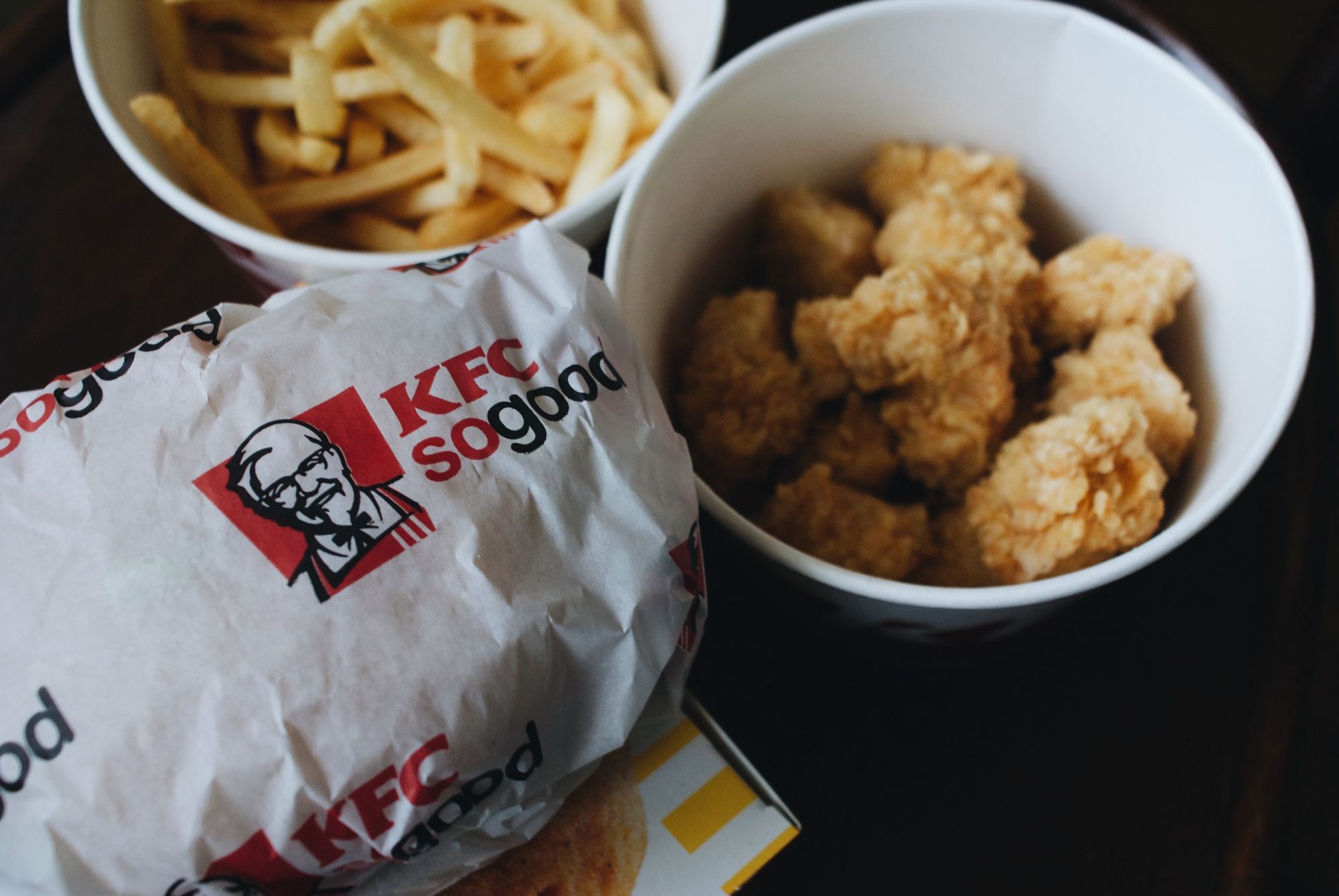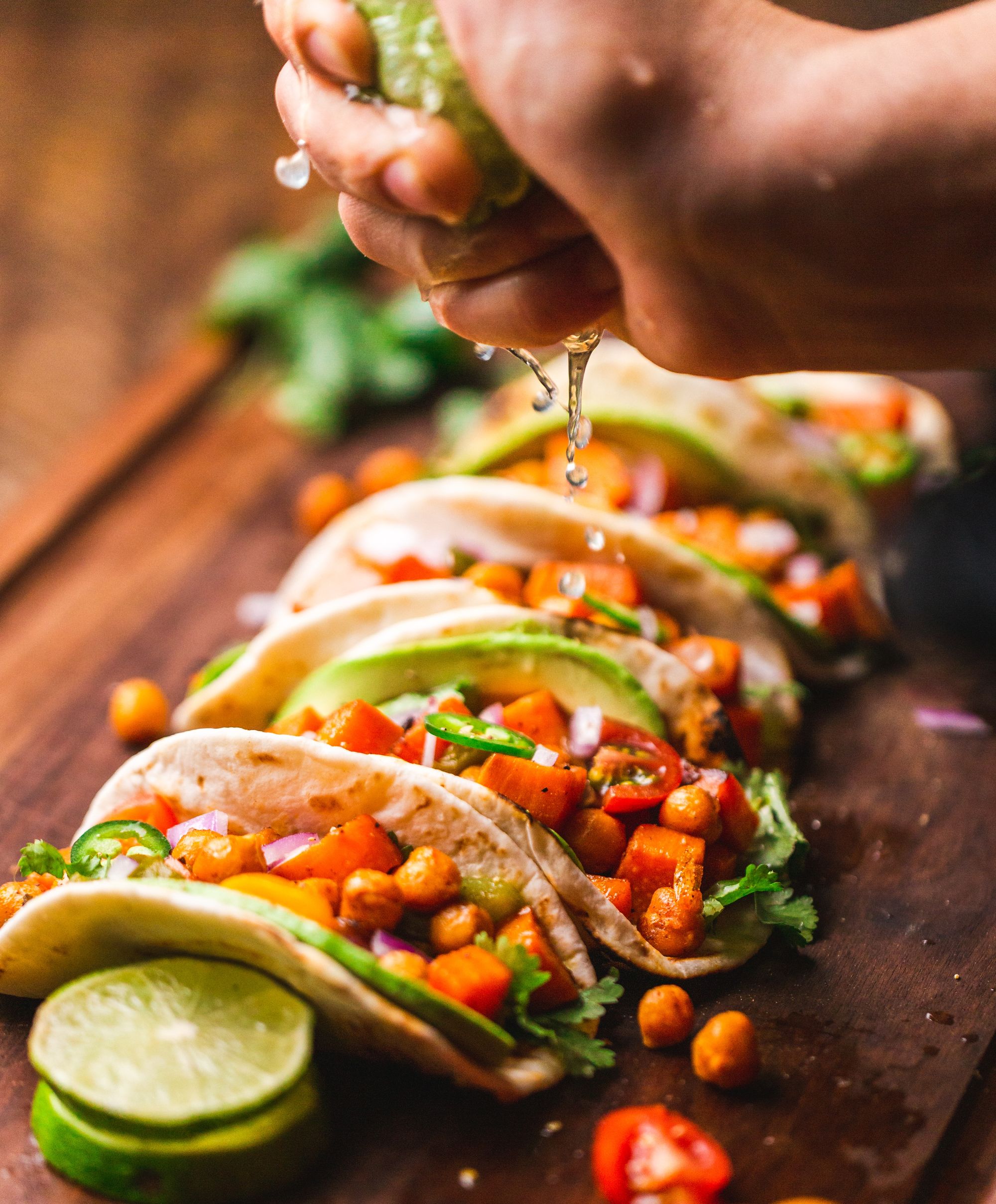Food Creative Ads: A Guide to Successful Ad Tactics
Research the world of food creative ads and discover the art of crafting mouth-watering visuals. Learn strategies that captivate taste buds and drive culinary desires.

Have you ever been captivated by a food advertisement that made you crave a certain dish or snack? Food creative ads can entice our taste buds and make us want to indulge in delicious treats.
But have you ever wondered what goes into creating these mouthwatering advertisements?
Whether it's the use of vibrant colors, the art of food styling, or the clever storytelling behind the ads, you'll discover how to create impressive food advertisements.
What Is Food Advertising?
Food advertising strategically and creatively promotes food products and services to a targeted audience to increase brand awareness, attract new target customers, and encourage repeat purchases.
This form of advertising encompasses various mediums, including print ads, digital advertisements, social media campaigns, and television commercials.
The main objective of food advertising is to entice consumers by showcasing delicious food, highlighting unique features or benefits, and creating a lasting impression.
By leveraging creative ad designs, effective messaging, and appealing visuals, food advertisers seek to capture the attention and interest of their audience, ultimately driving customer visits and boosting business performance.
Benefits Of Good Creative Ads
Good creative ads in the food industry have several benefits that can greatly impact a brand's success.
- Capture viewers' attention in a crowded advertising landscape. With compelling visuals, enticing copy, and effective storytelling, these ads stand out and draw viewers in.
- Ads spark conversations among consumers. Whether through humor, emotion, or thought-provoking messaging, these ads make people want to share and discuss them with others. This word-of-mouth promotion can create buzz around a brand and increase its visibility.
- Promote customer trust. By showcasing delicious food and highlighting the values and authenticity of the brand, they establish credibility and build a connection with the audience. Customers who trust a brand are likelier to become loyal and repeat customers.
- Attract new customers. With their ability to captivate and engage the target audience, these ads can expand the brand's reach and attract new customers who may not have previously known the brand.

6 Types Of Food Advertising
When it comes to food advertising, there are various types and strategies that brands can employ to capture the attention and interest of their target audience.
From print ads to digital advertisements, creative food marketing campaigns have the power to make a lasting impression on consumers.
Print Ads
Print ads play a crucial role in food advertising, effectively showcasing food products and leaving a lasting impression on the target audience. These ads utilize visuals, colors, and fonts to create visually appealing designs that capture viewers' attention.
The use of vibrant and delicious visuals in print ads helps highlight the food's deliciousness, enticing customers to try it. Bright colors like reds, greens, and yellows often evoke hunger and make the food stand out.
Fonts are carefully chosen to match the brand identity and convey the message effectively.
Print ads also play a significant role in promoting food brands. They can be strategically placed in magazines, newspapers, and billboards to reach a wide audience. By featuring mouthwatering close-ups of food, these ads create a desire among customers to visit the restaurant business or purchase the advertised product.
Moreover, print ads drive customer engagement by using compelling storytelling, offering discounts or promotions, and sharing customer stories or testimonials. These tactics help build customer trust and loyalty, increasing customer visits and satisfaction.
Digital Ads
Digital food advertisements have become essential to the highly competitive food and beverage industry, with over 31,000 companies vying for consumers' attention in the U.S. alone.
Creating effective ads requires a careful combination of humor, graphic design, strategy, and user engagement in this digital age.
Humor is a powerful tool that can grab consumers' attention and create a memorable and positive association with a brand. Clever and funny food advertisements entertain viewers and leave a lasting impression, setting a brand apart from its competitors.
Design plays a crucial role in catching the eye and evoking hunger. Creative and visually appealing ad designs that showcase mouthwatering food imagery can entice customers to try new dishes or visit a restaurant. Additionally, effective use of color, typography, and layout can help convey the brand's identity and message.
Today, user engagement is key. Interactive ads, games, polls, and contests keep users entertained and encourage them to participate actively, creating a stronger connection between the audience and the brand. This interactive element can increase brand awareness, customer loyalty, and higher conversion rates.
Video Ads
Video ads are an effective and engaging way to showcase food products and create a lasting impression on the audience. The only thing is you have limited time.
Different video ads can be used in food advertising campaigns, each with benefits and effectiveness in engaging viewers.
One type of video ad is the recipe video, where creating a delicious dish is visually depicted step by step. These videos showcase the food product and provide viewers with valuable information, inspiring them to try the recipe at home.
Recipe videos are particularly effective in engaging viewers because they combine the visual appeal of the food with practical instructions.
Another type of video ad is the behind-the-scenes video, which gives viewers a glimpse into making their favorite food products. These videos create a sense of authenticity and transparency, allowing the audience to connect with the brand and develop trust.
These videos can create a lasting impression on the audience by showcasing the passion and dedication that goes into creating food products.
Visual appeal is a key factor to consider when creating video ads for food advertising. High-quality footage, close-ups of the food, and delicious presentation can capture the viewer's attention and create a strong desire for the product.
Additionally, storytelling is important in engaging the audience and creating an emotional connection. Video ads can leave a lasting impression on viewers by telling a story that aligns with the brand's values and resonates with the audience.
Social Media Ads
Social media ads have revolutionized the way food advertising campaigns are conducted. With the rise of platforms such as Facebook, Instagram, and Twitter, companies have found a popular avenue for targeting and engaging with their millennial audience.
When it comes to social media food ads, creativity is key. Brands constantly push boundaries to create visually appealing and captivating content that captures viewers' attention scrolling through their feeds. From mouth-watering images of delicious dishes to beautifully shot recipe videos, these ads aim to entice and inspire consumers to try their products.
The strategic use of hashtags is another powerful tool in social media food advertising. Hashtags allow brands to categorize their content and make it more discoverable by their target audience.
Influencers also play a significant role in social media food advertising. Collaborating with popular food bloggers, chefs, or other influencers with a strong online presence can help brands expand their reach and tap into their followers' trust and loyalty.

These influencers can create engaging content featuring the brand's products, generating buzz and driving traffic to their profiles and websites.
Out-of-Home Ads
Out-of-home ads are a powerful and effective way to reach a wider audience and increase brand visibility in food advertising. These ads, such as billboards, transit stations, bus stops, and shopping malls, are displayed outside the home.
They offer unique opportunities for brands to capture consumers' attention and create memorable experiences.
One type of out-of-home ad used in food advertising is the billboard. These large outdoor displays allow brands to showcase their products with eye-catching visuals and minimal text.
The Burger King "BK Whopper" campaign is a successful campaign that utilized billboards. The ads featured closeup images of their delicious burgers, leaving viewers hungry and craving their mouth-watering offerings.
Another type of out-of-home ad is the transit ad. These ads are strategically placed in public transportation hubs and vehicles, targeting commuters and travelers.
Taco Bell's "Taco Bell's Late Night" campaign is a great example of a successful transit ad. They placed ads on buses and subways featuring their late-night menu items, effectively capturing the attention of late-night snackers.
Out-of-home ads benefit food advertising by allowing brands to target potential customers in specific locations.
Brands like McDonald's have used creative out-of-home ads like interactive bus shelters, promoting their products and entertaining and engaging commuters.
TV Commercials
TV commercials are vital in food advertising, leaving a lasting impression on viewers and enticing them to try the delicious offerings. This popular and effective advertising reaches a wide audience, making it an invaluable tool for food businesses.
In TV commercials, visual appeal takes center stage. Advertisers use high-quality food shots and close-ups to showcase the mouthwatering dishes, making viewers crave that delectable pizza or a juicy chicken burger.
One of the strengths of TV commercials in food advertising is the ability to captivate viewers with stunning visuals and expert storytelling within a short time frame. These ads are designed to impact the audience in seconds, leaving a lasting impression.
Additionally, they can be strategically timed to air during meal hours or popular TV shows, maximizing the exposure and reach.
Strategies For Creative Food Ads
Several strategies can help businesses stand out when creating effective food advertisements in a crowded market.
- Understanding the target audience and appealing to their interests and desires. By understanding their preferences, businesses can create ads that resonate with their customers and make them hungry for the products or services offered.
- Incorporating creativity is crucial to capture attention and differentiate from competitors. Whether through unique visuals, clever storytelling, or catchy jingles, creative elements can make an ad memorable and increase its chances of being shared.
- Leverage digital platforms and social media to reach a wider audience. Digital food advertisements can be highly targeted and personalized, ensuring the right message reaches the right people at the right time.
- Incorporating customer testimonials and stories can help build trust and establish brand loyalty. By showcasing satisfied customers and their positive experiences, businesses can demonstrate the value and quality of their offerings.
- Offering special promotions and discounts in ads can incentivize customers to take action and purchase. Employing these strategies helps businesses create effective and impactful food ads that drive customer engagement, increase brand recognition, and boost sales.
Understand The Audience And Brand Goals
Understanding the audience and brand goals is crucial for creating effective, creative food ads. Identifying the target audience, their preferences, and the brand's specific goals helps advertisers tailor their ads to capture the attention of the desired consumers.
When crafting food ads, it is important to understand the target audience. Are they health-conscious individuals? Are they fast-food enthusiasts?
Knowing the audience's preferences and interests will help advertisers create ads that resonate with them. For example, if the target audience is health-conscious, showcasing fresh ingredients and highlighting nutritional benefits would be more effective.
Furthermore, understanding the brand's business goals is just as vital. Whether it is increasing sales, promoting a new menu item, or building brand loyalty, the brand's goals will shape the creative direction of the ads.
For instance, if the goal is to promote a new burger, focusing on mouth-watering close-ups of the burger, accompanied by enticing descriptions, can help generate interest and drive sales.
Create Visuals That Appeal To The Target Audience
To create visuals that appeal to the target audience, visual storytelling techniques must be employed, with a special emphasis on the visual presentation of the food.
Visual storytelling involves using images and visuals to convey a narrative, evoke emotions, and engage the audience.
The first step is to determine the desired emotional reaction from consumers. For example, a brand targeting health-conscious individuals may want to evoke feelings of freshness and vitality.
Burger King's "Moldy Whopper" ad campaign is a prime example of visual storytelling that appeals to its target audience. The ad depicted a time-lapse video of a Whopper burger decaying, showcasing Burger King's commitment to using fresh ingredients.
Taco Bell's "Taco Bell's Best Year Ever" campaign featured real-life stories of loyal customers, creating emotional connections and lasting impressions.
Regarding visual presentation, close-ups of food can be used to enhance the appeal. Pizza Hut's print ads featuring melting cheese and oozing toppings entice the audience. Effective use of colors, lighting, and composition can also enhance the visual impact of the ads.

Memorable Color Combinations And Fonts
Choosing colors and fonts can greatly impact buying behaviors and build a strong brand identity.
Colors play a crucial role in engaging consumers and affecting their emotions. For example, red is commonly associated with excitement, passion, and appetite, making it a popular choice for fast-food chains like Burger King.
Green is often linked to freshness and health, making it ideal for salad bars or organic food brands. Blue evokes trust and reliability, making it suitable for beverage companies like Pepsi.
By strategically using colors that align with the desired emotions and associations, brands can influence consumer perceptions and decision-making.
Furthermore, fonts contribute to the overall image and identity of a brand. Whether a bold and playful font used by Taco Bell or a sleek and modern typeface chosen by pizza chains, it should align with the brand's personality and values.
Examples Of Creative Food Ad Campaigns
In modern life, brands constantly push boundaries to create innovative and compelling campaigns that showcase their delicious food and connect with their target audience.
From clever visuals to engaging storytelling techniques, some examples of successful creative food ad campaigns have captivated audiences and garnered widespread recognition.
1. Burger King's "Moldy Whopper" Campaign: Burger King took a bold and unconventional approach with their "Moldy Whopper" campaign. By showing the natural decay of their iconic Whopper burger over a period of 34 days, Burger King aimed to communicate their commitment to removing artificial preservatives from their menu.
2. Taco Bell's "Belluminati" Campaign: Taco Bell's "Belluminati" campaign was a tongue-in-cheek take on conspiracy theories. With a series of cryptic ads and an interactive website, Taco Bell created intrigue and curiosity among its audience.
3. Pizza Hut's "Taste Freedom" Campaign: Pizza Hut's "Taste Freedom" campaign aimed to highlight the joy of indulging in their delectable pizzas. The campaign featured a young boy named Junior who embarks on an adventure-filled quest to deliver a pizza. Through captivating visuals and an engaging storyline, Pizza Hut tapped into the audience's sense of adventure and conveyed that their pizzas are worth the journey.
Do's And Don'ts Of Food Ads
Food advertisements are crucial in attracting customers, increasing brand awareness, and driving sales for food businesses. However, creating effective food ads requires careful planning and execution.
To ensure that your food ads successfully capture the attention of your target audience and increase customer engagement, there are certain do's and don'ts that you should keep in mind. Here are some key guidelines that your marketing team can follow:
Do's:
- Highlight the delicious food: Your food ads should showcase the mouthwatering dishes you offer. Use high-quality, close-up images of the food to entice viewers and make them crave your offering.
- Tell a story: Engaging storytelling can make your food ads more memorable and relatable. Create narratives around your dishes, ingredients, or the dining experience to evoke emotions and create a lasting impression on your audience.
- Use creative visuals to capture attention by incorporating visually appealing elements in your ad designs. Play with colors, textures, and composition to make your advertisements visually striking and unique.
- Understand your target audience: Tailor your food ads to resonate with your specific audience. Consider their preferences, lifestyles, and values. A deep understanding of your target audience will help you craft messages that genuinely connect with them.
- Showcase variety: If you offer a diverse menu, highlight the range of dishes and options available. Showcasing variety helps potential customers understand your restaurant marketing strategy or food brands can cater to different tastes and preferences.
Don'ts:
Here are some examples of what you should avoid when creating food advertisements:
- Misrepresent the food: Avoid using misleading imagery or descriptions that do not accurately represent the actual food or ingredients. Building customer trust is crucial; misrepresenting your products can harm your brand reputation.
- Overload with information: Keep your food ads concise and to the point. Avoid overwhelming your audience with too many details or a cluttered visual layout. Instead, focus on your food offerings' key selling points and unique features.
- Use low-quality visuals: Poor-quality images or graphics can give the impression that your food is equally unappealing. Invest in professional photography or design resources to ensure high-quality and enticing visuals.
- Ignore customer satisfaction: Happy and satisfied customers are likelier to share their positive experiences and become loyal patrons. Highlight customer reviews, testimonials, or positive feedback in your food ads to build trust and credibility with potential customers.
- Neglect the importance of mobile: In today's digital age, mobile devices are a significant pathway for accessing information and purchasing. Optimize your food ads for mobile devices to ensure they are visually appealing and user-friendly on smaller screens.

Finishing Bite
Are you hungry yet? These photos and ads must have you thinking by now, about what you'd like to eat next? Creating effective and creative food ads is essential for the success of any food industry.
Today, when food trends and customer demands constantly evolve, it is crucial to stay ahead of the competition. Unique campaign ideas, a cohesive brand image, and social media marketing tactics are key to achieving this.
Successful digital food advertisements require innovative and attention-grabbing concepts that differentiate your brand. It is important to carve a niche for your food business by showcasing your unique selling points or innovative offerings
Food Creative Ads FAQ's
How do food creative ads differ from regular ads?
While regular ads focus on the product or service's features and benefits, Food Creative Ads emphasize the sensory experience, emotions, and cultural aspects associated with food. They aim to evoke cravings and create a lasting impression.
How do I measure the success of my food creative ad campaign?
Success can be measured using various metrics such as engagement rate, click-through rate, sales conversions, brand recall, and customer feedback. It's essential to set clear objectives before launching the campaign to effectively gauge its performance.
How do I choose the right platform for my food creative ad?
The choice of platform depends on your target audience, budget, and campaign objectives. Research where your audience spends most of their time online and tailor your ad to fit that platform's format and user behavior.
Are there ethical considerations in food creative advertising?
Yes, it's essential to represent food products accurately, avoid misleading claims, and be sensitive to cultural and health implications. Ethical advertising builds trust and long-term brand loyalty.
How do I ensure my food creative ad stands out in a saturated market?
Focus on authenticity, tell a unique brand story, leverage user-generated content, and continuously innovate in terms of visuals and messaging. It's also beneficial to keep an eye on competitors and identify gaps in the market.

